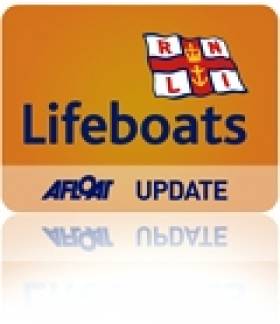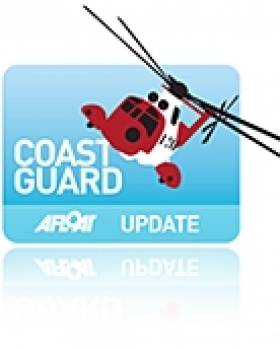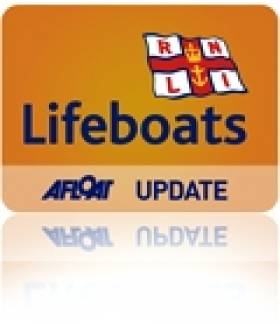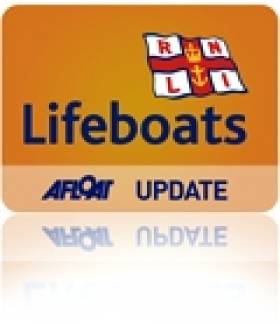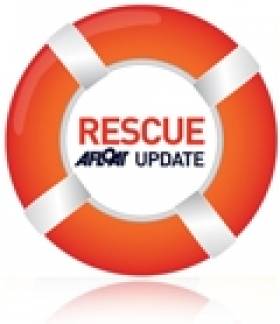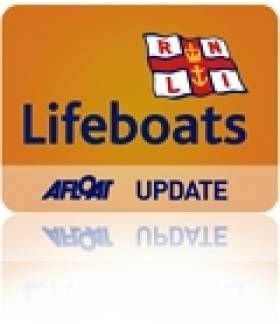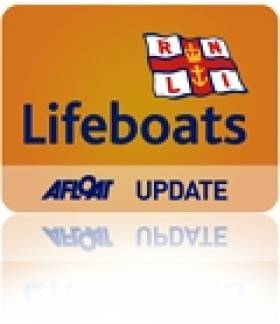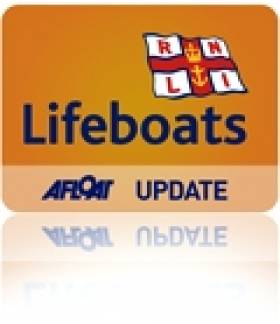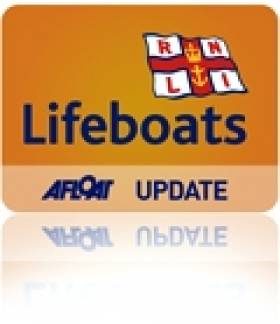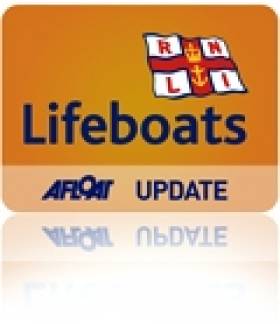Displaying items by tag: Lifeboats
Belfast Lough Hosts Major Maritime Exercise This Weekend
#LIFEBOATS - The Larne Times reports that Larne RNLI will be involved in a major maritime exercise in Belfast Lough this Sunday 23 September.
As many as 365 people will take part in 'Exercise Diamond', which involves vessels from the UK coastguard along with lifeboats, helicopters, search and rescue co-ordinators and other emergency services.
The exercise is intended to "test the major incident plans for all the organisations that would be involved should a major maritime incident happen in Northern Ireland," said controller Steve Carson.
Mayo Mountain Rescue Breaks Record for Call-Outs on Croagh Patrick
#COASTGUARD - Mayo's mountain rescue unit has reported its busiest ever period with an "unprecedented" 14 call-outs in just six weeks, according to The Irish Times.
Irish Coast Guard personnel assisted Mayo Mountain Rescue on four of the total, helping to winch people who had fallen while descending Croagh Patrick on the south side of Clew Bay.
The injury toll on the mountain - accounting for 10 of the 14 recovery efforts - has prompted Mayo County Council to seek planning permission for a helicopter landing pad higher up the 2,500-foot peak.
The news comes just after Enniskillen RNLI was names the busiest lifeboat station in the island of Ireland, with 23 launches between its two inshore lifeboats and two rescue water craft over the summer months.
Woman and Child Rescued from Stranded Dinghy in Kinvara
#LIFEBOAT - The Galway Advertiser reports that the Galway RNLI lifeboat came to the rescue of a mother and child from a small dinghy near Kinvara in the south-eastern corner of Galway Bay yesterday.
High winds and an offshore breeze caused the dingy to drift onto Mulrooney Island between Kinvara and Parkmore Pier, stranding the Dublin woman and her four-year-old son, who are holidaying in the area.
The lifeboat crew were dispatched to the scene by the Irish Coast Guard after being notified by a canoeist in the area who assisted the family. Both were wearing lifejackets at the time of the incident, and were taken back to shore unharmed.
Sligo Bay RNLI Rescues Two From Norwegian Yacht
#LIFEBOATS - The crew of the Sligo Bay RNLI lifeboat rescued two people from a 31ft Norwegian flagged yacht at the weekend.
The volunteer lifeboat crew was tasked by Malin Head coastguard shortly after 3.30pm on Saturday 18 August following a report that the vessel had got into difficulty.
Crew on board the inshore lifeboat Elsinore proceeded to the scene eight miles off Ballyconnell in Co Sligo. Weather conditions were good at the time with strong tides.
A man and a woman onboard the yacht had been on passage from the Labrador Coast in Canada on the final stretch of a voyage from their home in Oslo via the Caribbean and the east coast of America when they got into difficulty across the Atlantic.
Both of the yacht’s main sails were shredded in a gale and it subsequently suffered engine failure.
Arriving on scene, the lifeboat crew established a tow and took the vessel into Sligo Harbour, arriving after three hours. When the yacht was safely secured, the couple were brought into the Sligo Bay station where they were made comfortable.
Sligo Bay RNLI Lifeboat Operations Manager Willie Murphy said: "The couple were tired after being at sea for 21 days but were in good spirits. They were extremely grateful to the crew for their service and to all at the station for their assistance after."
This is the second time this summer that Sligo RNLI has had connections with Norwegian sailors.
In June, a 30-strong Norwegian shanty choir attended Rosses Points RNLI Shanty Festival to sing a song they had specially composed to commemorate the saving of a Norwegian crew off a shipwrecked sailing barque in the late 1800s on Coney Island in Sligo Bay.
Rescuers Guided to Donegal Swimmer By Woman With Binoculars
#RESCUE - The Irish Times reports on the rescue of a swimmer in distress off the Donegal coast thanks to the help of a woman with binoculars.
And the RNLI has paid tribute to the Malin Head coastguard unit for its knowledge of the area which was instrumental to the postive turn-out.
The man had been swimming off Five Fingers strand in Inishowen on Friday afternoon when he was washed out more than one-and-a-half miles into the sea.
The Malin Head unit of the Irish Coast Guard immediately co-ordinated the rescue effort, which saw both the Sligo coastguard helicopter and Lough Swilly RNLI lifeboat dispatched to the scene.
In an echo of June's 'miracle rescue' of a man in Cork Harbour after he was spotted by telescope, rescuers were assisted by a woman with an elevated view on the shore who spotted the swimmer and guided them to his location.
The man was quickly airlifted to Altnagelvin Hospital in Derry for treatment. He was said to be very traumatised after the incident.
“The outcome could have been different but for the local knowledge these guys have,” said Lough Swilly lifeboat spokesman Joe Joyce.
As previously reported on Afloat.ie, the coastguard radio stations at Malin Head and Valentia are both under threat of closure following a 'value for money' review of the State's marine rescue services.
Lough Derg Lifeboat Rescues Four from Grounded Cruiser
#lifeboat – Lough Derg RNLI Lifeboat launched tonight to assist 4 people whose cruiser was grounded and who abandoned their vessel to a small tender.
On Friday evening August 3 at 17.25hrs, Lough Derg RNLI lifeboat was requested to launch to assist four persons who abandoned their vessel to a small tender, after the cruiser grounded in Carrigahorig Bay, near Terrglass at the northern end of Lough Derg.
The lifeboat with Helm Peter Clarke, Ger Egan and Ben Ronayne on board, were already afloat assisting with the ongoing search in Garrykennedy. The lifeboat made way immediately to assist. It is reported that all four persons are safe and well. The rescue is ongoing.
Lifeboats Old and New Meet on the Aran Islands
#RNLI – A surprise return visit to the Aran Islands was made recently by former Galway Bay RNLI lifeboat Frank Spiller Locke. This restored Barnett class lifeboat was stationed at the Aran Islands from 1977 to 1985. She was previously stationed at Weymouth on the south coast of England. During her years of lifeboat service she was launched 396 times and saved 181 lives.
The lifeboat was funded through a legacy from Dr. Frank Spiller Locke. RNLI records show that his widow Mrs E. F. Locke took a strong interest in the work of the lifeboat and her volunteer crew and asked for the returns of service for every callout to be sent to her until her death.
The vessel was built in Cowes during 1958 at a cost of £38,500. It was a Barnett class lifeboat, which was introduced into the RNLI in 1950. Twenty of these 52 ft lifeboats were built by the charity. The institution retired and sold this lifeboat in 1986 and she was rescued sometime later by Colin and Janet Sturmer who are from the Isles of Scilly. They dedicated ten years to restoring this boat to its original form.
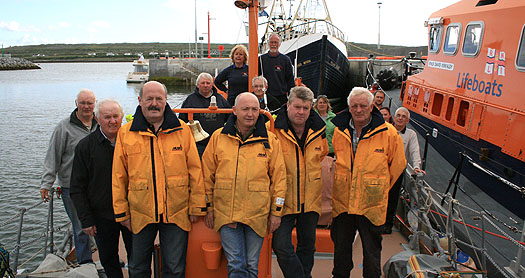
Pictured on the deck of the former Galway Bay lifeboat in yellow jackets are members of the current Aran Islands RNLI crew who also served on the Frank Spiller Locke lifeboat (L-R) Mairtin Fitz, Micheal O Goill, Johnny Mulkerrin, Enda Mullen.
"It was a lovely surprise to see this lifeboat in the Bay where she used to anchor in the 1980s" said Micheal Heron Aran Islands RNLI Lifeboat Operations Manager.
The two lifeboats, retired and current were moored side by side so that past and present crew could look over it. Four of the current lifeboat crew who served on the Frank Spiller Locke, Mairtin Fitzpatrick, Michéal Ó Goill, Johnny Mulkerrin and Enda Mullen, were joined by retired crewmembers Paddy Mullen, Bartley Mullen (Coxswain/Mechanic), Jackie Gill and Tomas Kelly. Many local people also came for a look and remembered stories of times that they or their families needed this lifeboat
Commenting on the visit, serving crewmember Micheal Gill added "there are a lot of differences in the speed and technology of these older boats. She served the west coast well at a time when there were only three lifeboats from Donegal to South Kerry and no helicopters.
This boat is a valuable piece of our maritime heritage, which has been lovingly restored bye Colin and Janet. Hopefully it will visit the west coast again in the future."
#rnli – Portaferry RNLI in County Down rescued two men in the early hours of this morning (Friday, 13 July) after a report that a rigid inflatable boat had collided with a yacht in Strangford Lough just off Killyleagh.
The lifeboat crew received a call from Coastguard at 2am following a report that a rib and a yacht had crashed and that both boats were sinking.
Crew launched its inshore Atlantic 85 lifeboat with four on board at 2.07am and made their way to the scene half a mile from land.
Weather conditions at the time were described as calm with no wind and with good visibility.
When the crew arrived on the scene they found two men in the rib but no one on board the yacht.
One man had sustained a minor head injury and both were taken by the lifeboat to a slipway at Killyleagh yacht club. The injured man was then taken to hospital by a friend who was waiting at the quay side.
Portaferry lifeboat crew then returned to the scene of the accident and secured both boats to a mooring before returning to base at 3.30am.
Deputy Launching Authority Lennie Lawson said the rescue was a credit to the volunteer crew who responded quickly and in numbers in the early hours of the morning: 'It was amazing how quickly our crew turned out and got to the scene launching within six minutes. Thankfully, weather conditions were favourable which assisted the crew in returning the casualty safely to shore'.
Lough Derg RNLI Lifeboat was launched to assist 3 persons aboard a 32ft cruiser that had an engine overheating problem.
#rnl i– Lough Derg RNLI lifeboat was requested by Valentia Coast Guard to assist 3 persons on board a 32ft crusier that was in danger of grounding on the Goat Road, south of Bellevue Point, after its engine had dangerously overheated. The skipper of the cruiser switched off his engine to prevent an engine fire. At 14.08hrs, the lifeboat launched with Helm Colin Knight, Eleanor Hooker and Tom Dunne on board. Winds were northerly, Force 4, and visibility was good.
The skipper of a passing barge, Knocknagow, advised the cruiser to drop anchor to prevent themselves being grounded on the Goat Road and raised the alarm. (The Goat Road is a rocky outcrop for migrating Terns. It is marked by the navigation mark E.
The cruiser passed a tow line to the barge, who took it under an alongside tow. When the lifeobat arrived on scene, they found all safe and well. An RNLI crew member was transferred to the cruiser, who passed the tow to the lifeboat. The cruiser was towed to Williamstown Harbour.
Lifeboat Helm, Colin Knight praised the skipper of cruiser for his swift action in cutting their engine saying that 'had he not noticed and been attentive to the overheating indicator, they would have been a definite risk of an engine fire on board'.
The lifeboat returned to station and was ready for service again at 15.15
Isle of Man Lifeboat Rescues Stranded Pleasure Craft
#LIFEBOATS - IOM Today reports that the Isle of Man's Peel RNLI lifeboat crew went to the rescue of the pleasure craft Flying Fox, which suffered an engine room fire some 22 miles off the island's west coast.
Flying Fox was en route from Strangford to Holyhead with one person on board when the fire occurred early yesterday, leaving the 34-foot Nelson-type vessel stranded in the Irish Sea.
Relief lifeboat Bingo Lifeline - replacing the stations main lifeboat, Ruby Cleary, which is currently in Holyhead for a refit - was dispatched with a volunteer crew, who found the boat after a "difficult" search.
The vessel was taken in tow back to Peel in moderate seas. No injuries were reported.


























